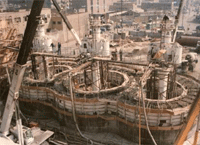Cairo Waste Water
 Image courtesy of tradearabia.com |
The master plan of the new wastewater collection system for Greater Cairo was designed with the main objective of removing wastewater from the urban areas of the city and to treat sewage to permit its safe re-use for the irrigation and crop fertilization of desert areas and the Nile delta. The master plan includes the construction of a main deep collector as well as a network of branch tunnels.
The tunnelling drives of the main collector and branch tunnels were completed and the major part of the new network was put into operation during the 1990s. Most of the tunnels were advanced through silt and clay layers underlain by sand layers. The construction of the major sections of the spine tunnel was completed using five bentonite slurry TBMs with an excavating diameter of up to 6.1 m. Two 6.1 m diameter Hydroshields were used for the northern section of the tunnel. Twenty access shafts were provided along the 12.2 km section of the spine tunnel. These shafts were constructed as pneumatic caissons. The tunnel was lined with precast reinforced concrete ribbed segments 0.8 to 1.0 m long as a primary lining. The secondary lining consisted of a cast in-situ reinforced concrete invert slab forming full shell with layers of acid-resistant blue bricks. Tens of kilometers of main branch tunnels were excavated using 3.25 m diameter TBMs. other smaller branch tunnels up to 1.0 m in diameter were constructed utilizing micro tunnelling techniques
The project was the subject of a publication under the Proceedings of the Institute of Civil Engineers - click here for a link to the publication in Google Books.